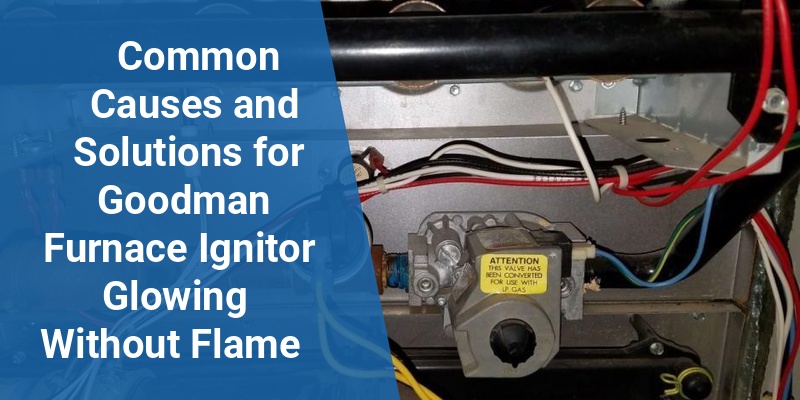When a Goodman furnace ignitor glows but no flame appears, it signals an ignition problem that can disrupt home heating. This issue has various underlying causes ranging from faulty gas supply to malfunctioning safety sensors. Identifying the exact cause is essential for effective troubleshooting and timely repair to restore warmth and safety. This article explores common reasons for the ignitor glowing without flame, along with detailed solutions tailored for Goodman furnaces.
| Cause | Symptom | Solution |
|---|---|---|
| Clogged or Shut Gas Valve | Ignitor glows but burner remains off | Check gas valve, ensure gas supply is on and clear any obstructions |
| Faulty Flame Sensor | Ignitor glows; furnace shuts off quickly | Clean or replace flame sensor |
| Ignitor Issues | Weak or inconsistent glowing | Replace ignitor element |
| Blocked Burner Orifice | No flame despite ignitor glow | Clean burner orifice thoroughly |
| Control Board Malfunction | No ignition despite normal indicators | Inspect control board circuit and replace if needed |
How Goodman Furnace Ignition Works
A Goodman furnace uses a hot surface ignitor (HSI) to light the burner. When the thermostat calls for heat, the control board sends power to the ignitor, causing it to glow red hot. This glow ignites the gas released by the valve, producing the flame that heats the air circulated through the ducts. The flame sensor then detects the flame presence and signals the control board to keep the gas valve open for continuous heating.
Common Reasons for the Ignitor to Glow Without Flame
Gas Supply Problems
A primary cause for a glowing ignitor but no flame is an interrupted or insufficient gas supply. The gas valve may be closed or partially blocked due to debris or malfunction. Without gas flow, the ignitor’s heat is ineffective since there is no fuel to ignite.
Flame Sensor Issues
The flame sensor is a safety device that detects whether the burner has successfully ignited. If the sensor is dirty or faulty, it may cause the furnace to shut off the gas valve prematurely even when the ignitor glows. This results in the flame failing to sustain despite the ignitor’s heat.
Ignitor Failure or Weakness
Though the ignitor seems to glow, it might not be reaching the necessary temperature or might be cracked. A weak or damaged ignitor may fail to ignite the gas properly, leading to no flame even if it appears operational.
Blocked Burner Orifice
The burner orifice controls gas flow into the combustion chamber. If it is clogged with dirt, dust, or rust, gas will not reach the ignitor effectively. Therefore, no flame will form despite the ignitor glowing as usual.
Control Board Malfunctions
The furnace control board governs sequencing, including when the gas valve opens and closes. A malfunctioning control board might energize the ignitor but fail to open the gas valve correctly, resulting in no flame generation.
Call 888-906-9139 for Free Local HVAC Quotes – No Obligation, Just Savings!
Detailed Troubleshooting Steps for Goodman Furnace Ignitor Glowing Without Flame
Step 1: Verify Gas Supply and Valve Status
- Confirm that the gas supply to the furnace is active and uninterrupted.
- Inspect the gas valve to ensure it is open and functioning. If the valve is stuck, it may require manual reset or replacement.
- Check for signs of gas leaks or damage in supply lines.
Step 2: Examine and Clean the Flame Sensor
- Turn off power and gas to the furnace before removing the flame sensor.
- Using fine steel wool or emery cloth, gently clean the sensor rod to remove oxidation and buildup.
- Reinstall the sensor and observe furnace operation. If the problem persists, consider replacing the sensor.
Step 3: Inspect the Ignitor
- Visual inspection can reveal cracks or damage to the hot surface ignitor.
- Test the ignitor’s resistance with a multimeter; readings outside the manufacturer’s specifications indicate a need for replacement.
- Replace the ignitor with a compatible Goodman-approved model if needed.
Step 4: Clean Burner Orifice and Surroundings
- Remove the burner assembly and check the orifice for blockages.
- Use compressed air or a thin wire to remove debris clogging the orifice.
- Ensure the burner ports are free and clear to allow proper gas flow.
Step 5: Test Control Board Functionality
- Check for error codes via the furnace indicator light or diagnostic LED blink patterns.
- Use diagnostic tools to confirm the control board sends correct signals to the gas valve and ignitor.
- If diagnostics point to control board failure, replace it according to Goodman’s guidelines.
Preventive Maintenance Tips to Avoid Ignitor and Flame Issues
Routine maintenance is crucial for reliable furnace operation. Schedule annual professional inspections focusing on the ignition system, flame sensor, gas flow components, and control board. Homeowners can:
- Keep the furnace clean and free from dust buildup.
- Monitor gas line integrity and ensure no obstructions exist.
- Perform regular flame sensor cleaning to avoid premature shutdowns.
- Replace defective ignition components promptly to prevent extended downtime.
When to Call a Professional HVAC Technician
If troubleshooting steps do not restore ignition, or if gas supply and safety concerns arise, contact a qualified HVAC technician. Complex issues like control board failures, extensive wiring problems, or gas valve replacements require expertise and specialized equipment to ensure safe repairs.
Additionally, always prioritize safety when handling gas appliances. Never attempt repairs beyond your skill level that involve gas connections, electrical components, or combustion chambers.
